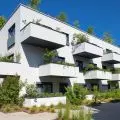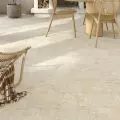It's no use two architectural competitions. The Complex of Music Schools in Poznań did not get a new seat and, by the decision of the Curia, goes into temporary exile. But in two years' time it will install itself at the Poznań Fair, next to the future headquarters of the Philharmonic. In this way, one of the oldest fair buildings will return to its glory.
The target location of the school is very good news: both the music institution and the Fair will benefit. For the time being, however, the Music School Complex at 90 Glogowska Street in Poznań has to leave the building it has occupied for the past 45 years. It will move from the downtown district of Lazarz (two stops from the Central Railway Station) to the poorly connected periphery. For the next two years, the musicians will commute to an office building formerly occupied by the Poznań Rolling Bearing Factory on Nieszawska Street (the building now belongs to Poznań University of Technology).
two competitions in the sand
The school is changing its address because the Poznań Curia, which owns the modernist school building from 1931 (designed by Adolf Piller, originally: Female Teachers' Seminary), is planning to renovate and modernize it, as well as to use the building for other purposes (similar to what happened a decade ago with the neighboring building of the 8th High School). The intention to terminate the lease has been known for years, but despite years of efforts, it has not been possible to build a new building with a real purpose. There were even two competitions for the design of a new complex in an interesting location on 28 Czerwca 1956 Street, right next to the Wildecki Market. However, the Ministry of Culture and National Heritage, to which the institution is directly subordinate, could not find the funds for the construction.
First prize in the first competition for the music school building on 28 Czerwca Street in Poznań—proj. Plaskowicki & Partners Architects, 2014; SARP Competition No. ZP-2015-002211
© Plaskowicki & Partners Architects
Financial problems were also behind the organization of two, rather than one, competitions. The first was held in 2014, the second—a year later. The competition had to be repeated, as it turned out that the Ministry of Culture and National Heritage did not have enough funds to implement a project with an extensive functional program. Slimming down the awarded project was not possible, so a new competition had to be held. In the first competition, the winning studio was Plaskowicki + Partners Architects. In the second: PIW PAW Architects. Unfortunately, the efforts and resources of these and other participating studios were wasted.
First prize in the second competition for the building of the music school on 28 Czerwca Street in Poznań—proj.: PIW PAW Architects, 2015.
© PIW PAW Architects
not so ornate anymore
Semi-official information about the school's move to the Fairgrounds had been heard since April, although some media quoted inaccurate information that the new headquarters was to be the building occupied until 2019 by the School of Form. Meanwhile, as Karolina Niementowska of the MTP Group confirms to us, the building in question is the historic Administration Building. It's a building in an excellent location—opposite the train station and on the same street as before (14 Glogowska Street), only closer to the very center.
Municipal Market Office, designed by Stefan Cybichowski, 1924; view from Glogowska Street, as of 1926
© National Digital Archive, photo from the Illustrated Daily Courier
The edifice was constructed together with the neighboring Fair Palace in 1925 to serve the needs of the dynamically developing Poznań Fair (with international status from the same year). Both buildings were designed in competition by Stefan Cybichowski, a noted architect of the interwar period. The forms of the buildings were very conservative and aroused objections even in the 1920s, when many buildings also formally referring to the styles of the pre-partition Republic were being built all over the country.
Municipal Office of Poznań Fair, designed by Stefan Cybichowski, 1924; view of the belvedere from the side of the fairgrounds, as of 1926
© National Digital Archive, photo from the Illustrated Daily Courier
TheAdministration Building, together with the belvedere in the rear, took on a neo-Baroque costume (very decorative interiors), while the Fair Palace took on a classicist style. Both buildings—heavily damaged during the war—were rebuilt in a very simplified form. The Administration Building lost its hipped roof and many decorative details. Until the 1990s, a large neon sign above its cornice read "Welcome to Poznań."
MTP Administration Building, 1970s
© MTP Archives
The mutilated belvedere, which before the war housed one of the city's more upscale dining establishments, served from 1957 as the studio of Poznań Television (until the 1990s). Today, like the decapitated Market Palace, it houses warehouses, among other things. The buildings are essentially the oldest structures of the Fair. More ancient is only the partially preserved steel structure of the Upper Silesian Tower, damaged during the war (1911, designed by Hans Poelzig), which is the base of the 1955 Fair Spire (designed by Boleslaw Szmidt).
MTP Administration Building, view from Pewuki Square; in the foreground, the sheltered belvedere building
photo: Jakub Głaz
more and more music
Currently, the office building of the Building is in a deplorable condition. The music school is therefore scheduled to move into it after extensive renovation and restoration of its pre-war appearance (including an overbuilt attic floor).
The MTP Administration Building, view from Pewuki Square, left: the neglected Belvedere; foreground: part of the new walkway between the West Railway Station and Sniadeckich Street
Photo: Jakub Głaz
Karolina Niementowska of the MTP Group reports that
it will be necessary to carry out repair and construction work and adapt the building for educational purposes. The expected completion date is autumn 2025.
The decision to move the school to the Fair seems very sensible. After all, the Fair is now changing the character of the southern part of its grounds (conferences and large events instead of exhibitions) by slowly opening up to the city. Last year they built a public plaza for the Universal National Exhibition (Pewuki) over a new three-level parking lot.
Pewuki Square, view from the south, from the right: hall No. 2, administrative building, Exhibition Center, East entrance
Photo: Jakub Głaz
This year they intend to finally open both the square and the shortcut running through the fairgrounds between the Western Railway Station and Sniadeckich Street permanently for residents ( we recently described the project for a walkway called "Green River"). Unfortunately, the date for the adaptation for catering, entertainment purposes of hall No. 2 between Pewuki Square and Glogowska Street is again delayed.
The site for the philharmonic hall / music center (right); on the left—the existing conference center, in the middle—part of the walkway through the Fair ("green river")
© MTP Group
The passage, meanwhile, is to be the target site for the Poznań Philharmonic, which to this day has not lived up to its edifice and concert halls. The competition for the design of this so-called Music Center has also caught a slip. It was supposed to be announced last year; now there is talk of a deadline this year. Two perfectly located musical institutions: a school and a philharmonic hall, have a chance to strongly and sensibly revitalize the congressional space of the Fair finally made available to Poznań residents. Let's hope for it as soon as possible and without further delays.




















































